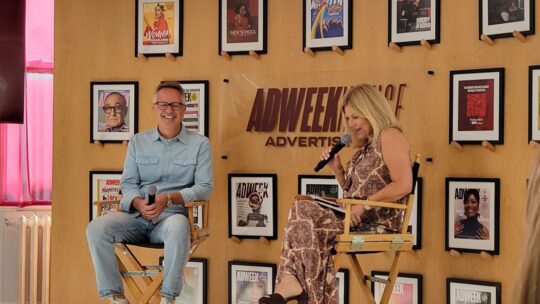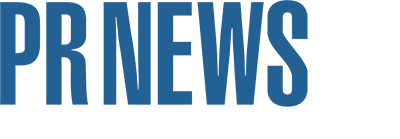
This week's PR Roundup reviews the first public appearance of American Eagle Chief Marketing Officer, Craig Brommers, since this summer's Sydney Sweeney jeans (or genes) debacle, a new study showing not everyone in PR is enthused about AI, and how Getty learned what it's audience needed through reading data.
American Eagle CMO Says Sweeney Ad Not a Crisis, but an Opportunity
What happened: Thousands of communicators, creators, marketers and advertising execs descended on New York City this week for the annual Advertising Week conference. Discussions on everything from AI ethics to the creator economy and audience polarization filled the venue, and those conversations did not stop there.
Other tertiary events popped up around the city surrounding the conference including the economic forum and cultural festival, Blackweek, DKC’s AI Evolution Communications Summit and ADWEEK House, just to name a few.
ADWEEK House hosted the AE CMO, Brommers, for his first public speaking engagement since the Sydney Sweeney jeans controversy this summer. Brommers described (to a packed room) how the story impacted him and his staff personally as well as the business and explained the company’s behind-the-scenes strategies in the wake of the original onslaught of negativity on social media and in the news.
Brommers started by saying he doesn’t think he has ever been this tired before, but that it’s been an exhilarating and fascinating ride.
“When we set out to create the jeans campaign of 2025, with the IT girl of 2025, the goal was not to participate in culture, but to define culture,” Brommers says. "It is absurd to say that we were creating a campaign that had anything to do with promoting eugenics, Nazism or white supremacy. It's absurd. And a vast majority of Americans knew that."
He says the campaign has exceeded his wildest dreams due to the attention it has received and is still receiving.
“As many in the room know, just this last Saturday night, this was still in the news,” he says. “This was on Saturday Night Live, and I feel like … I can't believe that anything, especially something in our advertising world, is still commanding this amount of attention 10 weeks later.”
Communication takeaways: However, it’s taken a long time to get to this point 10 weeks later. Brommers credits the mindset of his American Eagle team for navigating the especially negative moments.
“So many people said, you’re navigating a crisis,” he says. “We never actually thought that. We actually said we’re optimizing an opportunity.”
Brommers explained that his team and the brand overall had to make some difficult decisions in regards to responding to the commotion.
“On one hand, we had to do something very quickly, and on the other hand, we did nothing,” he says. “I think on one hand, we actually had to get a read from real Americans, not the social media noise, not the traditional press noise. We actually had to get a real read on what our customers thought … we got that very quickly, and that gave us a lot of confidence to be able to execute the campaign as it originally intended.”
The hardest thing, Brommers said, was the next part: doing nothing.
“You have a crisis communications industrial complex that is telling you to do this playbook that has been around for decades,” he says. “We actually did the opposite. We actually did nothing and just read the room for a moment, because that's what we needed to do.”
American Eagle went into a quiet period from June 27 to September 3, taking the time to monitor and measure the actual encouraging performance of the campaign.
Brommers offered advice for other CMOs going through similar situations. These included:
- “Social media is very noisy. It’s not reality. You have to deal with reality and what is going on. Understand what your customers think.”
- “Talent partnerships … the word partnership is in bold, caps and underlined. And I have to give Sydney Sweeney and her team credit. She stuck with us, and you better be damn certain that we will stick with her.”
- “The CEO/CMO relationship is so important to cement before something like this happens … It allowed me to look [my CEO] in the eye and say it’s full steam ahead, we know what we are doing here.”
PR Industry Divided on AI
What happened: Onclusive recently released its “PR, Comms & Marketing 2026 Outlook” report, which shows a growing split in how communicators view AI’s role in their work. While many are embracing AI’s time-saving and efficiency-boosting potential, a sizable group fears the industry is downplaying how disruptive it could become.
Despite all the talk of innovation, most pros are taking a pragmatic approach—leaning on AI for content production, translation and measurement, rather than overhauling how they work. But with only 10% of in-house practitioners and 14% of agency pros expecting ethics to significantly affect their roles in 2026, questions remain about how the industry will handle issues like bias, transparency and oversight as AI tools become more embedded in everyday PR practice.
Key findings include:
- 41% of PR practitioners don’t expect AI to drastically change their role in 2026.
- 28% believe the industry is underestimating AI’s broader impact.
- 30% of in-house vs. 25% of agency pros say the industry is underestimating AI’s disruption.
- 41% of agency respondents expect AI to let them focus on strategy—only 26% of in-house agree.
Communication takeaways: Jennifer Roberts, Chief Marketing Officer at Onclusive, says that while the PR industry is torn on whether AI is a friend or foe, many practitioners are moving beyond experimentation into everyday use which prioritizes efficiency gains.
“What’s certain is that PR cannot afford to sit back and wait,” Roberts says. “Whether you’re an AI evangelist or a skeptic, the industry must engage with this technology—not only to use it effectively, but to ensure it is applied ethically.”
Roberts also noted from the data that 2026 will be a defining year for communicators and marketers.
“The rules are shifting: budgets are tighter, expectations are higher, and the spotlight on results has never been stronger,” she says.
The study also shows that proving impact is no longer an afterthought; it is becoming the foundation of effective decision making, and practical AI usage can play a role.
“Senior leaders are demanding more than coverage reports or click-through rates; they want clear evidence of how communications and marketing activities move the needle for their business,” Roberts says. “This shift is forcing both brands and agencies to re-examine how they plan, execute and evaluate their work.”
Land O’Lakes and Getty Images Launch Effort to ‘Repicture’ Rural America
What happened: Land O’Lakes is not just about butter and cheese.
The brand teamed up with Getty Images to challenge outdated depictions of rural America with a new initiative called “Repicturing Rural.” The program includes a playbook and curated visual library designed to help media outlets, brands and agencies move past clichés and tell more authentic stories about rural communities. The effort builds on Land O’Lakes’ “Modern Rural Collective (MRC),” which unites storytellers and marketers to reshape how both rural and urban audiences see modern rural life.
Getty Images found a need for this type of content by looking at data. VisualGPS data shows growing interest in this genre—searches for rural visuals were up 22% in 2024 and 8% so far in 2025—but also a significant perception gap, with two-thirds of rural Americans saying advertisers don’t understand them. Through “Repicturing Rural,” Getty and Land O’Lakes aim to close that gap by offering real-world resources that reflect the diversity, complexity and vibrancy of today’s rural communities.
Communication takeaways: Listening to your customers can open doors to new product and content ideas. Getty discovered this need by letting its data tell the story.
“In the United States, visuals depicting rural communities have long been oversimplified, or are simply inaccurate,” says Tristen Norman, Head of Creative for the Americas at Getty Images. “When it comes to advertising and marketing, the visuals that do focus on rural places oftentimes do not represent the complexity and diversity inherent to these communities.”
And in acknowledging where a brand maybe lacking, it can grow a deeper connection with its community.
“Through this initiative, we are empowering those people who shape our visual culture—media outlets, publishers, brands and ad agencies—to use visuals that reflect the richness of rural life today in ways that paint a more accurate picture while meaningfully connecting with communities across the country,” Norman says.
Nicole Schuman is Managing Editor at PRNEWS.
